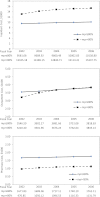Medication nonadherence in diabetes: longitudinal effects on costs and potential cost savings from improvement
- PMID: 22912429
- PMCID: PMC3507586
- DOI: 10.2337/dc12-0572
Medication nonadherence in diabetes: longitudinal effects on costs and potential cost savings from improvement
Abstract
Objective: To examine the longitudinal effects of medication nonadherence (MNA) on key costs and estimate potential savings from increased adherence using a novel methodology that accounts for shared correlation among cost categories.
Research design and methods: Veterans with type 2 diabetes (740,195) were followed from January 2002 until death, loss to follow-up, or December 2006. A novel multivariate, generalized, linear, mixed modeling approach was used to assess the differential effect of MNA, defined as medication possession ratio (MPR) ≥0.8 on healthcare costs. A sensitivity analysis was performed to assess potential cost savings at different MNA levels using the Consumer Price Index to adjust estimates to 2012 dollar value.
Results: Mean MPR for the full sample over 5 years was 0.78, with a mean of 0.93 for the adherent group and 0.58 for the MNA group. In fully adjusted models, all annual cost categories increased ∼3% per year (P = 0.001) during the 5-year study time period. MNA was associated with a 37% lower pharmacy cost, 7% lower outpatient cost, and 41% higher inpatient cost. Based on sensitivity analyses, improving adherence in the MNA group would result in annual estimated cost savings ranging from ∼$661 million (MPR <0.6 vs. ≥0.6) to ∼$1.16 billion (MPR <1 vs. 1). Maximal incremental annual savings would occur by raising MPR from <0.8 to ≥0.8 ($204,530,778) among MNA subjects.
Conclusions: Aggressive strategies and policies are needed to achieve optimal medication adherence in diabetes. Such approaches may further the so-called "triple aim" of achieving better health, better quality care, and lower cost.
Figures

Similar articles
-
Regional, Geographic, and Ethnic Differences in Medication Adherence Among Adults with Type 2 Diabetes.Ann Pharmacother. 2011 Feb;45(2):169-78. doi: 10.1345/aph.1P442. Ann Pharmacother. 2011. PMID: 21304026
-
Longitudinal effects of medication nonadherence on glycemic control.Ann Pharmacother. 2014 May;48(5):562-70. doi: 10.1177/1060028014526362. Epub 2014 Feb 28. Ann Pharmacother. 2014. PMID: 24586059
-
Comorbid depression is differentially associated with longitudinal medication nonadherence by race/ethnicity in patients with type 2 diabetes.Medicine (Baltimore). 2016 Jun;95(25):e3983. doi: 10.1097/MD.0000000000003983. Medicine (Baltimore). 2016. PMID: 27336900 Free PMC article.
-
Repaglinide : a pharmacoeconomic review of its use in type 2 diabetes mellitus.Pharmacoeconomics. 2004;22(6):389-411. doi: 10.2165/00019053-200422060-00005. Pharmacoeconomics. 2004. PMID: 15099124 Review.
-
Meta-analysis of studies examining medication adherence, persistence, and discontinuation of oral antihyperglycemic agents in type 2 diabetes.Curr Med Res Opin. 2015;31(7):1283-96. doi: 10.1185/03007995.2015.1053048. Epub 2015 Jun 18. Curr Med Res Opin. 2015. PMID: 26023805
Cited by
-
Material need insecurities, control of diabetes mellitus, and use of health care resources: results of the Measuring Economic Insecurity in Diabetes study.JAMA Intern Med. 2015 Feb;175(2):257-65. doi: 10.1001/jamainternmed.2014.6888. JAMA Intern Med. 2015. PMID: 25545780 Free PMC article.
-
Persistence with Basal-Bolus Insulin Therapy in Patients with Type 2 Diabetes Mellitus and Effect on Clinical and Economic Outcomes: A Retrospective Claims Database Study.J Manag Care Spec Pharm. 2019 Dec;25(12):1420-1431. doi: 10.18553/jmcp.2019.19097. Epub 2019 Sep 24. J Manag Care Spec Pharm. 2019. PMID: 31550190 Free PMC article.
-
The efficacy and safety of once-weekly DPP-4 inhibitor omarigliptin in patients with type 2 diabetes mellitus: A systemic review and meta-analysis.Medicine (Baltimore). 2018 Aug;97(34):e11946. doi: 10.1097/MD.0000000000011946. Medicine (Baltimore). 2018. PMID: 30142816 Free PMC article.
-
Long-term Effects of Disasters on Seniors With Diabetes: Evidence From Hurricanes Katrina and Rita.Diabetes Care. 2019 Nov;42(11):2090-2097. doi: 10.2337/dc19-0567. Epub 2019 Sep 23. Diabetes Care. 2019. PMID: 31548250 Free PMC article.
-
Guideline Development for Medical Device Technology: Issues for Consideration.J Diabetes Sci Technol. 2023 Nov;17(6):1698-1710. doi: 10.1177/19322968221093355. Epub 2022 May 7. J Diabetes Sci Technol. 2023. PMID: 35531901 Free PMC article.
References
-
- Centers for Disease Control and Prevention. National Diabetes Fact Sheet: General Information and Estimates on Diabetes in the United States Atlanta, GA, U.S. Department of Health and Human Services, 2011. Available from http://www.cdc.gov/diabetes/pubs/factsheet11.htm
-
- Narayan KM, Boyle JP, Geiss LS, Saaddine JB, Thompson TJ. Impact of recent increase in incidence on future diabetes burden: U.S., 2005-2050. Diabetes Care 2006;29:2114–2116 - PubMed
-
- Agency for Healthcare Quality and Research. 2010 National Health Disparities Report Rockville, MD, U.S. Department of Health and Human Services, 2010 (Rep. no. 11-0005). Available from http://www.cbo.gov/publication/41656
-
- Nathan DM, Buse JB, Davidson MB, et al. American Diabetes Association. European Association for Study of Diabetes Medical management of hyperglycemia in type 2 diabetes: a consensus algorithm for the initiation and adjustment of therapy: a consensus statement of the American Diabetes Association and the European Association for the Study of Diabetes. Diabetes Care 2009;32:193–203 - PMC - PubMed
-
- U.S. Department of Veterans Affairs. VA/DoD clinical practice guidleline for the management of diabetes [Internet], 2011. Available from http://www.healthquality.va.gov/diabetes/DM2010_FUL-v4e.pdf Accessed 6 December 2011

